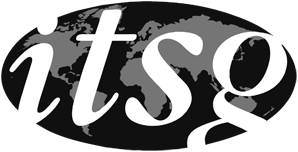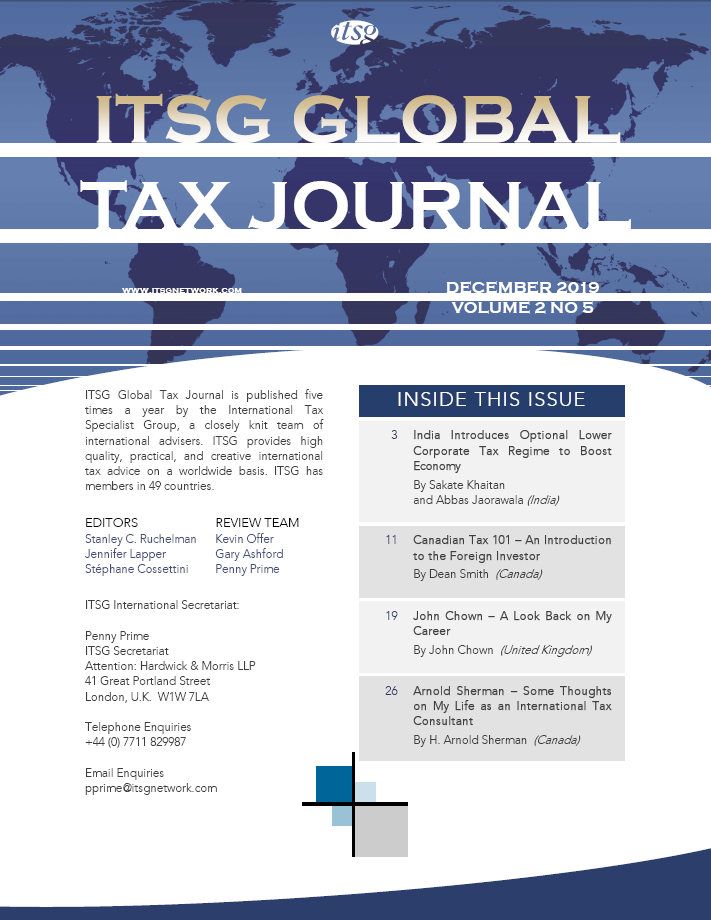Canada is an attractive place to conduct business. It benefits from the Comprehensive Economic and Trade Agreement (C.E.T.A.), unofficially known as the Canada-Europe Trade Agreement; the North American Free Trade Agreement (N.A.F.T.A.), scheduled to be replaced by the U.S.-Mexico-Canada Agreement; the Comprehensive and Progressive Agreement for Trans-Pacific Partnership (C.P.T.P.P.); and other trade agreements. It has enacted investor protection laws and has low corruption, minimal levels of red tape, and a tax system that provides for tax-free treatment of intercompany dividends received from foreign subsidiaries.
Canada has a well-developed tax system based on concepts that give credence to contractual provisions between parties, albeit subject to a general anti-abuse rule. This article provides an introduction to that tax system for the benefit of a foreign investor looking to expand operations to North America.
GENERAL
Canada imposes an income tax on individuals, corporations, and trusts. Income taxes are levied at the Federal and provincial or territorial levels of government. Canada has ten provinces1 and three internal territories2.
Federal income taxation is imposed pursuant to the Canadian Income Tax Act (the Act). Three separate government bodies play a role in income taxation in Canada. The Department of Finance (Finance Canada) is responsible for analysing and developing tax policy and for implementing tax legislation. The Canada Revenue Agency (C.R.A.) is responsible for administering the Act and collecting taxes. The Department of Justice is involved when tax disputes go to court.
Residents of Canada are subject to tax on worldwide income. Non-residents are subject to Canadian taxation on Canadian-source income only, though exemptions or reductions may be permitted by virtue of a tax treaty. Non-residents will be subject to regular income tax on three types of income:
- Employment income exercised in Canada,
- Profits from a business carried on in Canada, and
- Gains from the disposition of taxable Canadian property (T.C.P.), such as Canadian real property.
Other types of income, such as interest, dividends, rents, and royalties are subject to a flat non-resident withholding tax. The provinces, in general, do not impose any taxes on non-business income earned by a non-resident.
When capital property is sold, one-half of a capital gain (known as a taxable capital gain) is included in the computation of taxable income and is taxed at the taxpayer’s applicable tax rate.
The Federal government also imposes a value-added tax (V.A.T.) called the Goods and Services Tax (G.S.T.) or Harmonized Sales Tax (H.S.T.), depending on the province in which the supply takes place.
Canada does not impose wealth taxes, capital taxes, or stamp duties. Municipalities impose a property tax on the assessed value of real property interests. Land transfer taxes are levied on the sale or transfer of real property interests, but an exemption exists in the event of death for assets passed to heirs or estates. All provinces impose probate fees.
TAX TREATIES
Regarding income tax treaties and other agreements, as of 1 December 2019:
- 93 income tax treaties are in force; four have been signed but are not yet in force; and eight are under negotiation.
- Canadian tax treaties generally follow the Model Tax Convention on Income and on Capital (Model Treaty) of the Organisation of Economic Cooperation and Development (O.E.C.D.).
- 24 tax information exchange agreements are in force; one has been signed but is not yet in force; and five under negotiation3.
- Canada has 58 social security agreements with other countries in force4.
Canada is a signatory to the Multilateral Convention to Implement Tax Treaty Related Measures to Prevent Base Erosion and Profit Shifting (Multilateral Instrument) of the O.E.C.D. It came into force on 1 December 2019 and will begin to apply to affected income tax treaties as of 1 January 2020. It has adopted minimum standards except for binding arbitration for treaty disputes.
FREE TRADE DEALS
In addition to C.E.T.A., N.A.F.T.A., and C.P.T.P.P., free trade agreements are in effect with the following countries: Chile, Colombia, Costa Rica, Honduras, Israel, Jordan, Korea, Panama, Peru, and Ukraine.
CORPORATION TAX
Residence
A corporation that is resident in Canada is taxed on its worldwide income. A foreign corporation doing business in Canada would be subject to Canadian tax only on its Canadian-source income, subject to a limitation under an applicable income tax treaty.
With limited exception for certain corporations formed prior to 27 April 1965, a corporation that is formed under Federal or provincial law is deemed to be a tax resident in Canada. Corporations formed elsewhere may be considered tax-resident in Canada if managed and controlled in Canada on principles formulated under English case law. Typically, this means the place where central management and control is exercised. For many foreign companies, the mind and management issue should not be a factor in determining residency status in Canada. It becomes an issue for private foreign companies where the owner/manager moves to Canada. As such, it is possible that a corporation may be a tax resident in Canada and elsewhere. In those circumstances, taxpayers must refer to an applicable income tax treaty to determine a company’s residence.
Business income
Canada taxes the profits of taxpayers carrying on business. The term ‘business’ implies a certain level of activity in comparison to passive investment.
The starting point in determining a corporation’s taxable income is its accounting income computed in accordance with generally accepted accounting principles or generally accepted business practices. Accounting income is then modified by specific rules contained in the Act.
In general, an expenditure is deductible in computing taxable income if it has been incurred for the purpose of gaining or producing income and is reasonable in the circumstances. Capital outlays, accounting reserves, expenses associated with exempt income, and expenditures for recreational facilities and club dues are not deductible.
A foreign company that is resident in a treaty country and doing business in Canada may be exempt from Canadian corporate tax if the company does not maintain a permanent establishment (P.E.) in Canada. Where the company has a P.E. in Canada, Canadian tax would be imposed only on the income from activities associated with the P.E. Where a foreign company does not have a P.E. in Canada, Canadian-source income is exempt from Canadian taxation. Nonetheless, the foreign company must file a Canadian corporate tax return to disclose its reliance on the treaty.
If a company is carrying on business in more than one province through a P.E. in each province, the business must apportion its business income to each province. The method of apportionment is based on revenues earned and wages paid in each province.
Property income
Dividends, interest, rents, and royalty income are taxable in Canada when received. Compound interest securities are subject to accrual requirements, generally on an annual basis. Other income is taxed as received or allocated, depending on the circumstances.
Canada exempts intercompany dividends. Dividends received from a taxable Canadian corporation will not be subject to a second level of corporate taxation when paid to a Canadian-resident corporation. Dividends received from a foreign corporation are subject to a somewhat different rule.
Dividends received from a foreign corporation will be excluded if the foreign entity is a foreign affiliate and the dividend is paid out of the foreign corporation’s exempt surplus. In broad terms, a foreign affiliate is a non-resident corporation in which the Canadian-resident corporation’s equity percentage is not less than 1% and the total of the equity percentages in the corporation of the taxpayer and each person related to the taxpayer is not less than 10%. Special interpretive rules apply to preclude double counting. Exempt surplus refers to the foreign corporation’s tax adjusted retained earnings from active business income carried on in a country with which an income tax treaty or an information exchange agreement is in force with Canada.
Capital cost allowance
Though a general deduction on capital expenditures is denied, depreciation under the capital cost allowance (C.C.A.) is deductible. Under this system most assets are grouped into particular classes and the entire class is depreciated at a set percentage on a declining balance method. Leasehold improvements are depreciated on a straight-line basis over the life of the assets.
The claiming of the C.C.A. is not mandatory. Catch-up claims are not permitted. If a property is disposed of in excess of its undepreciated capital cost (U.C.C.), the C.C.A. is recaptured as ordinary income. The balance results in a capital gain and only half is taxable. A terminal loss results if all the assets in a class are disposed of by the end of the year but a positive balance remains in the class.
In the 2018 Fall Economic Statement, the government announced provisions allowing for an accelerated depreciation on certain classes of assets, including (i) specified clean energy equipment (Class 43.1 and 43.2), (ii) manufacturers and processors machinery and equipment (Class 53), and (iii) and enhanced first-year allowance.
Rates and filings
Corporation tax returns are due six months after the fiscal year-end. The general Federal corporate tax rate for 2019 is 15%. Canada does not permit the filing of consolidated tax returns. Consequently, corporate groups must plan the coordination of tax liabilities and loss utilisation within the corporate group.
For all provinces other than Alberta and Quebec, a joint Federal/provincial/territorial return is filed. Alberta and Quebec require the filing of separate provincial tax returns. Provincial and territorial rates vary from 10% to 16% and are paid in addition to the Federal tax. Tax is due if the corporation conducts business in a province or territory through a P.E. If not, an additional 10% Federal tax applies.
Thin capitalization
Canada imposes limits on how much deductible interest can be paid to specified non-resident investors. A non-resident is specified if, along with any related parties, it owns 25% of the shares of any class of the capital stock of the corporation and the debt owing to specified non-residents exceeds 150% of equity. The disallowed interest expense is recharacterized as dividends subject to non-resident withholding tax. The non-resident withholding tax rate is 25%. Where a treaty exists, the dividend withholding tax rate is reduced to 15% in general and 5% when the shareholder is a foreign corporation owning 10% or more of the voting power in the Canadian company.
Transfer pricing
In general, Canada follows the O.E.C.D. guidelines set out in its 1995 document, Transfer Pricing for Multinational Enterprises and Tax Administrations. Canada’s transfer pricing legislation embodies the arm’s length principle and requires that, for tax purposes, the terms and conditions agreed to between related parties be those expected had the parties been unrelated. Under the arm’s length principle, related parties would be treated as if they are separate entities. The principle requires a comparison of prices or margins between related parties on cross-border transactions with prices or margins on similar transactions between unrelated parties. It is a factual determination as to whether a taxpayer has adhered to the arm’s length principle.
Methodologies such as the comparable uncontrolled price (C.U.P.) method, the resale price method, the cost/plus method, the profit split method, and the transactional net margin method (T.N.M.M.) are examples of strategies devised to determine an arm’s length transfer price. Recently, however, tax authorities have attempted to allocate or apportion profits based on relative costs. This reflects certain views of the O.E.C.D. expressed as part of the B.E.P.S. Action Plan.
Where the Canadian tax authorities have determined that the transfer price employed does not reflect the price that would have been charged between arm’s length parties, the income for Canadian tax purposes can be adjusted accordingly. Depending on the amount of the adjustment (percentage and dollars), penalties may be imposed.
A company’s transfer pricing methodology is routinely examined by C.R.A. to determine whether an appropriate transfer pricing methodology is in place and contemporaneous documentation exists to support its methodology. Companies may apply to C.R.A. for an Advance Pricing Arrangement (A.P.A.) to reduce its risk of adjustment.
Scientific research and experimental development credits
The scientific research and experimental development (SR&ED) program encourages businesses to conduct research and development (R&D) that leads to new, improved, or technologically advanced products, processes, devices, and materials. Qualifying SR&ED expenditures are deducted as business expense. The may also be claimed as investment tax credits (I.T.C.s) that reduce income taxes payable.
Qualifying SR&ED expenditures include wages, materials, and equipment leases, overhead that is directly related to R&D, and eligible work by contractors. Experimental development, i.e., technological advancement, applied research, the advancement of knowledge for a practical purpose and basic research, and the advancement of knowledge for its own sake, are activities that would qualify. Eligible activities include engineering, design, operations research, mathematical analysis, computer programming, data collection, testing, and psychological research. In order to claim such expenditures, an assessment on scientific or technological eligibility of the claimed activities needs to be performed.
Foreign companies may qualify for a non-refundable investment tax credit at the basic rate of 15% on qualified SR&ED expenditures. As such, foreign companies may consider moving R&D activities to Canada to take advantage of the Canadian R&D credits. Canadian-Controlled Private Corporations may be entitled to cash refunds of I.T.C.
Withholding considerations when undertaking activities in Canada
Whenever a non-resident of Canada performs services in Canada other than in the capacity as an employee, the payor must withhold and remit 15% of the payment to C.R.A. Where a chain of transactions exists, the withholding tax obligation applies to non-residents paying other non-residents for services performed in Canada. Consequently, if a U.K. general contractor wins a contract in Canada and hires a U.S. company as a subcontractor, the Canadian-resident payor withholds and remits 15% of the payment made to the U.K. general contractor, and the U.K. general contractor withholds and remits 15% of the payment made to the U.S. subcontractor.
The 15% withholding is not the final tax. The withholding is a payment on account of the non-resident's potential tax liability in Canada. The non-resident would then file a Canadian income tax return to calculate the final tax liability. If the non-resident taxpayer can demonstrate it is exempt from Canadian tax pursuant to a treaty, the full 15% withholding tax is refunded. If the non-resident has a P.E. in Canada, the 15% withholding tax will be applied against the ultimate tax liability.
If a non-resident obtains a waiver from C.R.A., the 15% withholding may be reduced by reason of an income tax treaty or to reflect anticipated expenses.
INDIVIDUALS
Residence
No statutory definition of residency for individuals exists in the Act. Case law provides that residence status is based on particular facts and circumstances. Significant ties to Canada include presence plus a home available for use, immediate family in Canada, and children attending school in Canada.
Canada has a sojourner rule under which a non-resident who spends more than 183 days in Canada during the calendar year is deemed to be resident throughout the entire year. In counting days, any part of a day counts as a full day. There are no exceptions for day of arrival or departure.
When an individual is considered a resident of a foreign country and Canada under each country's tax law, sole residence is determined under the residence tiebreaker of an applicable treaty. Canada’s treaties generally follow the O.E.C.D. Model Treaty in this regard and applies several tests to resolve the matter in specific order. The tests are permanent home, centre of vital interest, habitual abode, nationality, and mutual agreement. The first test that resolves the issue is applied, without going further.
Employment income
Income from employment includes all amounts received as salary, wages, commissions, director’s fees, bonuses, gratuities, and taxable benefits. Taxable benefits take many forms. Employer-provided housing, schooling, automobiles, and membership dues are examples of typical taxable benefits. Exceptions exist for employer-provided board and lodging where the employee is in Canada on a temporary basis and the employee has maintained a principal residence elsewhere.
Employer-provided stock options exercised, while in Canada, would be subject to Canadian taxation. If certain conditions are met, a deduction may be given in computing the employee's taxable income. If the options were owned prior to the employee moving to Canada, the full employment benefit would be included in income, but the employment benefit would need to be sourced between Canada and the foreign country on a reasonable basis. The portion considered foreign source would be eligible for a foreign tax credit in Canada.
All remuneration received by a resident of Canada is taxed in Canada, including items relating to a pre-Canadian period of employment but received on a deferred basis after Canadian tax residence is established. All compensation for services performed outside Canada should be received prior to the establishment of Canadian residence. Items relating to a period of Canadian employment would be taxable in Canada, even if the amount is paid after the employee has left Canada.
There are no special concessions for the compensation of individuals who are arriving residents of Canada.
Business income
The rules for individuals carrying on business in Canada are similar to the rules for corporations carrying on business in Canada. It may be easier, however, for a foreign individual to have a P.E. in Canada. Often, C.R.A. asserts that an individual conducting a business in Canada maintains a P.E. in Canada if a Canadian telephone number or Canadian mailing address exists for the business.
Property income
Similar to corporations, interest, dividends, rents, and royalties are taxed when received. Dividends from taxable Canadian corporations are taxed at a reduced rate through a partial integration system involving a gross-up of the dividend to reflect taxes imposed on pre-tax income and a tax credit mechanism for the taxes triggering the gross-up.
Many non-residents who move to Canada on a temporary basis maintain ownership of their foreign principal residence but let it to offset some of the carrying costs. As a Canadian resident, the foreign-source rental income must be reported. Tax depreciation and C.C.A. may be claimed to reduce net rental income, but losses cannot be created or increased through the use of tax deprecation.
Capital gains
One-half of the net capital gains (i.e., taxable capital gains) on the disposition of capital property are included in the calculation of taxable income. Allowable capital losses (one-half of the net loss) can be applied only against taxable capital gains. Unused capital losses may be carried back three years and forward indefinitely.
The Federal government provides incentives for Canadian residents to start Canadian active businesses in Canadian corporations. When a start-up business is successful and a Canadian-resident individual sells the shares for a gain while the corporation is a Qualified Small Business Corporation, the gain may qualify for a capital gains exemption, subject to a lifetime cap that increases with inflation. To be a Qualified Small Business Corporation, at least 90% of the fair market value of the company's assets must be used in an active business carried on primarily in Canada. Where a capital loss arises on the disposition of shares or debts of certain small business corporations, 50% of the loss may be deducted against all types of income not just capital gains. These types of allowable capital losses are known as allowable business investment losses (A.B.I.L.).
A capital gain arising on the disposition of an individual’s principal residence is not subject to tax. A principal residence can be located in a foreign jurisdiction. Families can designate only one property per calendar year as a principal residence.
When a taxpayer becomes a resident of Canada, all capital assets owned by the taxpayer are deemed to be acquired at fair market value on the date residence commences. When a taxpayer ceases to be resident in Canada, all capital assets are deemed to be sold at fair market value pursuant to Canadian departure tax rules. The resulting taxable capital gain for appreciation during the period of Canadian residence is included in the last Canadian tax return. If the individual has not been resident in Canada for more than 60 months, any assets owned at the time Canadian residence commenced are excluded from the departure tax rules.
Other
If a particular item of income, other than employment, business, property, or capital gains, is not specifically listed in the Act, it is not subject to taxation. Other types of income listed in the Act include the receipt of pensions (Canadian or foreign), annuities, employment income, Canadian Old Age Security (O.A.S.), government pension plans such as the C.P.P., and withdrawals from Registered Retirement Savings Plans (R.R.S.P.). Income from lottery winnings is not listed and not subject to tax in Canada.
Tax year, returns, and rates
The Canadian tax year is the calendar year. In general, personal tax returns are due by the following 30 April. Self-employed individuals have until 15 June to file, though taxes should be paid by 30 April. Penalties and interest will be applied to late-filed returns that have a balance due. Below are the 2019 Federal tax rates.
Combined Federal/provincial returns are filed for all jurisdictions except Quebec. Quebec residents are required to file a separate Quebec form in addition to the Federal form.
Income tax rates are graduated. In 2019, the maximum Federal tax rate was 33%, reached at taxable income of C.D.N. $210,371. Provincial tax rates vary. The rate that applies depends on the province or territory of residence on 31 December of the taxation year. The maximum Ontario tax rate for 2019 was 20.53% (after applying the top surtax rate of 56%) and when added to Federal tax results in a maximum combined rate of 53.53%.
Trusts
Persons moving to Canada may have connections to foreign trusts. Canadian tax implications will depend on the residence of the trust. As with an individual, the residence of a trust or estate is determined by reference to applicable facts and circumstances. Historically a trust was considered to be resident where the trustee, executor, administrator, heir, or other legal representative who manages the trust or controls the trust assets resides. In recent years, C.R.A. also takes into account:
- Control over changes in the trust's investment portfolio,
- Responsibility for the management of any business or property owned by the trust,
- Responsibility for any banking, and financing, arrangements for the trust,
- Control over any other trust assets,
- Ultimate responsibility for preparation of the trust accounts and reporting to the beneficiaries, and
- The power to contract with and deal with trust advisors, such as lawyers and accountants.
Notwithstanding the general rules, if a trust has a resident contributor or resident and connected contributor, a trust may be resident in Canada for income tax purposes. The Canadian courts have also looked at the concept of mind and management in determining the residence of a trust. This approach implies that some non-resident trustees may not be exercising their fiduciary responsibilities appropriately and that they are acting as agents on behalf of others, who may be the settlors or beneficiaries of the trust.
Trust income or capital gains may be attributed to the person transferring property to the trust if the transferor has a right of reversion or retains a power of appointment. In addition, if the property can be disposed of only with the concurrence of the initial transferor who is Canadian resident, any income or loss or taxable capital gain or allowable capital loss from the property, or property substituted for it, will be attributed to that person while resident in Canada.
In general, trusts are taxed at a flat rate that is equal to the highest marginal tax rate. However, a testamentary trust may qualify as a Graduated Rate Estate (G.R.E.) for up to 36 months from the testator’s date of death.
Resident and deemed-resident trusts are taxable on worldwide income. When trust income is distributed to a beneficiary, the distribution is deductible for the trust and taxed in the hands of the beneficiary.
G.S.T., H.S.T., AND PROVINCIAL SALES TAXES
G.S.T./H.S.T. is a V.A.T. that applies to most supplies of goods and services in Canada. Registrants making taxable supplies must collect tax from the customer at the applicable rate. If the supply is zero-rated or exempt, no tax is due. Zero-rated supplies include basic groceries; agricultural products, such as wheat, grain, and raw wool; prescription drugs; and international passenger air travel. Exempt supplies include most health, medical, and dental services; long term rentals of residential accommodation; and most services provided by financial institutions.
Registrants must pay Input G.S.T./H.S.T. on goods or services imported into Canada for use, consumption, or supply in the course of commercial activities. Registrants remit additional tax or receive a refund a refund of tax for the difference between the G.S.T./H.S.T. collected and the Input G.S.T./H.S.T. paid.
Rates
Canada imposes a 5% Federal G.S.T. on taxable supplies made in Canada. Most provinces have a provincial sales tax. Alberta, Nunavut, the Northwest Territories, and the Yukon do not impose any provincial sales tax. Five provinces eliminated provincial sales tax in order to be harmonized with the Federal G.S.T. In those provinces, the G.S.T. is known as the H.S.T. The H.S.T. rate is 15% in New Brunswick, Newfoundland and Labrador, Nova Scotia, and Prince Edward Island. The rate in Ontario is 13%. The provincial portion of the H.S.T. is the amount in excess of the base G.S.T. rate of 5%. The G.S.T./H.S.T. is collected by C.R.A. on behalf of the Federal government and those provinces who harmonized.
The province of Quebec imposes its own V.A.T., in addition to the Federal G.S.T., called the Taxe de ventu du Québec (T.V.Q.). The current rate is 9.5%, and the tax is applied to the price after G.S.T. is imposed. The effective rate is 9.975%.
The retail sales tax rate is 7% in British Columbia and Manitoba and 6% in Saskatchewan.
CONCLUSION
In sum, Canada has a well-developed tax system that is monitored by a highly professional C.R.A. Canada is a party to income tax treaties with many countries and trade agreements with Europe, the U.S., and Pacific economies. As a result, Canadian businesses can benefit from low import duties in major markets and attractive provisions in its tax law that can be used to reduce the effective tax rate for global business.
1 Alberta, British Columbia, Manitoba, New Brunswick, Newfoundland and Labrador, Nova Scotia, Ontario, Prince Edward Island, Quebec, and Saskatchewan.
2 Northwest Territories, Nunavut, and Yukon.
3 Finance Canada, ‘Tax information exchange agreements’, modified 9 July 2014.
4 Government of Canada, ‘Canada’s social agreements with other countries’, modified 21 November 2018.

 Login
Login





















































